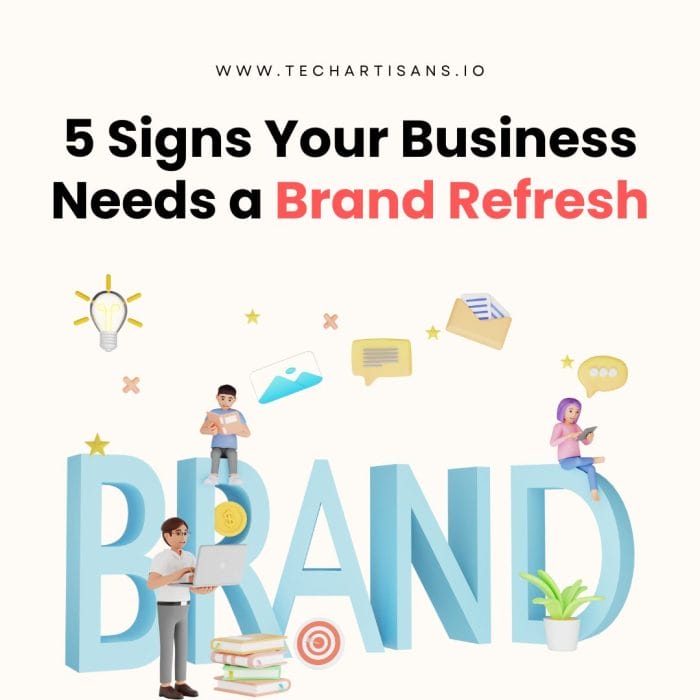An influential brand stands as a cornerstone for business triumph. It not only distinguishes you from rivals but also embeds a lasting memory in the minds of your customers. However, when brands lose their appeal to the target audience, the consequences can be profound.
In today’s fiercely competitive arena, lacking a strong brand presence renders you susceptible to fading into obscurity, which in turn can severely undermine the trajectory of your business’s advancement. In this article, we will discuss 5 signs your brand needs a refresh.
5 Signs Your Brand Needs a Refresh

Possibly, an extended period has elapsed since your last brand update, or you’ve observed a decline in engagement from customers.
Regardless of the underlying cause, the time might have arrived for you to revitalize your brand presence. Whether you opt for subtle refinements to contemporize your existing brand or embark on a complete overhaul, embracing change has the potential to invigorate your brand’s trajectory.
Some of the world’s most prominent and successful companies have judiciously refreshed and evolved their branding over time, ensuring their resonance with both consumers and the dynamic market environment.
A brand refresh needn’t entail an overhaul of your corporate identity. On the contrary, even modest adjustments can wield remarkable effects in refreshing your branding and infusing it with renewed vitality.
Outlined below are five pivotal indicators that signal the advantageous prospect of reassessing the image your business projects to the market. Additionally, we offer insights on commencing the process of transformation.
Rebrand and Brand Refresh

Before we delve into the subject, it’s important to clarify the distinctions between a brand refresh and a rebranding effort.
Rebranding involves a comprehensive overhaul, akin to reconstructing a structure from its foundation. Your fundamental identity and brand strategy are discarded, providing a clean slate to reimagine:
- Brand positioning
- Branding values
- Brand guidelines
- Mission and vision statements
- Overall visual branding
Despite retaining the same name, a rebrand results in a substantially different appearance – a deliberate transformation.
On the other hand, a brand refresh entails minor adjustments aimed at bestowing a renewed, refined, and contemporary aura upon your brand. These modifications might encompass:
- Fine-tuning your present design or just a logo
- Updating your tagline
- Altering your color palette and visual identity
- Revitalizing marketing materials
- Adopting a new typeface
Perhaps you’re still uncertain whether your brand warrants a refresh. Eager to proceed? Here are five telltale signs to watch for.
1. Visually Inconsistent Brand Identity

What’s the common thread among nearly all widely recognized household brands? It’s their unmistakable identification. Consider Nike – a swift glance at the swoosh and it’s instantly recognizable. Similarly, Coca-Cola boasts its iconic red hue accompanied by white script.
Building a strong brand identity and customer perception of your brand is a gradual journey, yet these brands have mastered a singular principle: visual consistency.
The visual identity of your brand encompasses:
- Logo
- Color Palette
- Graphic Elements and Textures
- Fonts
- Branding Imagery
These visual components hold immense significance as they constitute the foremost impression people encounter. This principle extends across every facet of your brand’s presentation, spanning social media platforms, websites, graphics, signage, print and paid advertisements, and beyond.
Should these elements lack uniformity, they can lead to customer perplexity or hinder recognition. To establish a robust brand messaging and visual identity, collaborate with your team to craft a comprehensive and unwavering Brand Guide. Seeking seasonal inspiration? Explore our latest blog post on harnessing seasonal elements.
2. Your Values Aren’t Reflected in Your Brand

Your aspiration should be for your brand to assume a position of leadership, not mere adherence. Embrace attributes that distinguish your brand and prominently showcase your values. Emulating your competition and replicating their values will inevitably result in a sense of disorientation and inauthenticity.
What holds significance to you? What is your brand story? What value do you aim to offer your customers through your brand and why? These inquiries carry paramount importance in the endeavor to forge your identity and image.
3. Not Catering For Expanding Audience

Witnessing a brand’s expansion is undeniably one of the most rewarding experiences. It signifies the fruition of your relentless efforts. However, as your audience expands, new demographics and heightened responsibilities emerge. The expectations of your new audience might encompass a desire for increased engagement from your side.
Furthermore, it’s crucial to acknowledge that your brand isn’t static; it has evolved from its inception. Consequently, your communication with the audience needs to evolve as well, reflecting these changes and embracing novel approaches.
To navigate the challenges that come with growth, we advocate convening with your team to craft a strategic blueprint for managing the enlarged audience. This calls for envisioning fresh campaigns and innovative methods of outreach that transcend your previous strategies.
Additionally, consider collaborating with new content creators to infuse a fresh perspective. Seek inspiration from our blog dedicated to influencer marketing for insightful concepts.
4. Outdated Design Look

The appearance of your brand’s design should exude a sense of freshness and contemporaneity, steering clear of a lackluster and antiquated look. Our conviction aligns with the adage that just because something was effective in the past doesn’t guarantee it remains relevant today. Even if your logo doesn’t resemble something conjured in Microsoft’s “Paint” program, it still might warrant a rejuvenation.
Remarkably renowned brands often refresh their logos and branding every few years to remain attuned to contemporary design trends. Apple’s logo evolution stands as a noteworthy illustration of this practice. Embrace the prospect of integrating novel visual elements into your graphics or even introducing a fresh color or two without trepidation.
5. Inconsistent Brand Tone

Lastly, it’s imperative to ensure a seamless and consistent dissemination of your revitalized brand across all communication channels. This encompasses your website, social media platforms, advertising endeavors, corporate vehicles, warehouses, and marketing materials.
This consistent communication serves a dual purpose: it reassures your customers that these changes have been undertaken with their best interests in mind, while simultaneously fostering trust and loyalty towards the newly amalgamated or acquired business.
Unexpected shifts in branding, messaging, or product line stemming from internal corporate discord can bewilder consumers, potentially prompting them to explore alternatives to meet their product needs.
A merger or acquisition presents a distinctive opportunity to refine your brand, allowing it to mirror the essence of the new organization and generate a harmonious brand identity. This strategic approach effectively communicates the alterations to your customer base and manifests your commitment to nurturing trust and loyalty within the new target market.
Concurrently, it upholds enduring relationships with those who have ardently championed your brand over years, if not decades.







